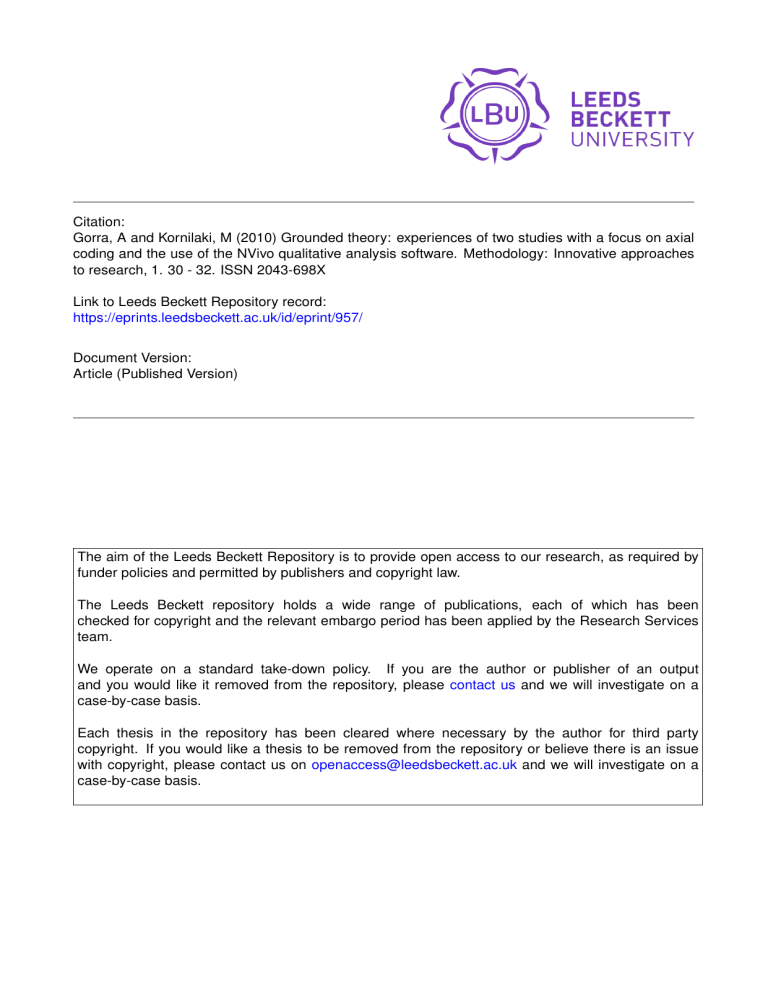
Citation: Gorra, A and Kornilaki, M (2010) Grounded theory: experiences of two studies with a focus on axial coding and the use of the NVivo qualitative analysis software. Methodology: Innovative approaches to research, 1. 30 - 32. ISSN 2043-698X Link to Leeds Beckett Repository record: https://eprints.leedsbeckett.ac.uk/id/eprint/957/ Document Version: Article (Published Version) The aim of the Leeds Beckett Repository is to provide open access to our research, as required by funder policies and permitted by publishers and copyright law. The Leeds Beckett repository holds a wide range of publications, each of which has been checked for copyright and the relevant embargo period has been applied by the Research Services team. We operate on a standard take-down policy. If you are the author or publisher of an output and you would like it removed from the repository, please contact us and we will investigate on a case-by-case basis. Each thesis in the repository has been cleared where necessary by the author for third party copyright. If you would like a thesis to be removed from the repository or believe there is an issue with copyright, please contact us on openaccess@leedsbeckett.ac.uk and we will investigate on a case-by-case basis. Grounded theory - experiences of two studies with a focus on axial coding and the use of the NVivo qualitative analysis software Dr Andrea Gorra Lecturer Business School Faculty of Business &and Law a.gorra@leedsmet.ac.uk Marianna Kornilaki Lecturer Events and Festival Research UK Centre for Events Management Leslie Silver International Faculty m.kornilaki@leedsmet.ac.uk 1 Introduction This article recounts personal experience of one of the analytical steps followed in Grounded Theory Methodology (GTM), based on the empirical experience and theoretical knowledge of a tourism and an information technology researcher. The research aim of Author 2Marianna’s PhD was to investigate the factors that influence the decisions of small tourism business owners to adopt sustainable practices in their business operations. Author 1Andrea examined the implications of the long-term storage and use of mobile phone location data on individuals’ perceptions of privacy (Gorra, 2007). Here we will illustrate how we used the more abstract ways of coding, namely axial coding, as well as our experiences of using the qualitative analysis software QSR NVivo. 2 Grounded theory and axial coding GTM is an inductive and systematic qualitative methodology that has been widely used in various disciplines (see for example Bryant &and Charmaz, 2007; Charmaz, 2006; Strauss &and Corbin, 1998; Glaser &and Strauss, 1967). GTM originated in the USA in the 1960s in the fields of health and nursing studies, and through its inception Anselm Strauss and Barney Glaser wanted to counter the dominance of positivistic research that tested existing theories. Since then the method has undergone various changes and different ‘flavours’ of GTM have emerged. The data collections conducted by both authors included several stages, following a cyclical process of using early findings to shape the on-going data collection and analysis in order to develop a theoretical explanation of the phenomenon under study (see Figure 1). Figure 1: Steps in developing a grounded theory (adapted from Strauss and Corbin, 1998) The analytical process in GTM involves different coding strategies, which aim to break the raw data down into units, uncover new concepts and novel relationships and to systematically develop categories which are then put back together to build a theory (Charmaz, 2006; Goulding, 2002; Strauss and& Corbin, 1998). The types of coding typically employed in a GTM study are: open coding, focused or selective coding, axial coding and theoretical emergence. Figure 2 provides a visual overview of the coding steps followed in GTM according to Strauss and Corbin (1998). Figure 2: Coding steps in grounded theory (adapted from Strauss and& Corbin, 1998) 2.1 Axial coding in practice This article focuses on axial coding and the identification of the relationships between the categories of concepts emerging from the data analysis. The aim of axial coding is to add depth and structure to existing categories. Charmaz (2006) explains that axial coding reassembles data that has been divided into separate codes by open coding. Strauss and Corbin use axial coding to investigate conditions of situations described in the interview, their actions and consequences by ‘relating categories to subcategories along the lines of their properties and dimensions’ (Strauss &and Corbin, 1998, p. 123). Author 2Marianna applied Strauss and Corbin’s axial coding and identified the characteristics, properties and dimensions of each category along a continuum or two axes. By taking, for example, transcripts relating to one emerging concept, the ‘Tour operator’s powerful role’, she was able to identify the properties and their dimensional range. The following figure gives an example of the category ‘Tour Operator’s (TO’s) powerful role’ and its properties. These properties and dimensions were derived from open coding of the transcripts, from sentences, words and phrases the participants used, which indicated an array of influences and behaviour implications. Properties Dimensions Figure 3: Author 2Marianna’s category ‘Tour operator’s powerful role’ and its dimensions Through this Author 2Marianna identified variations in business owners’ behaviour depending on different circumstances and environments, their different prioritisation of actions and strategic responses to events and problems. Linking categories at the level of their properties and dimensions was a time-consuming and difficult process which produced rather descriptive results. However, this coding helped her to understand how, when, where, why and with what results the participants relate themselves to the natural and cultural environment and how they make sense of their world. Through all these questions she was able to describe in more depth the studied phenomenon and to specify the subcategories of the core category. Author 1Andrea aimed to utilise Strauss and Corbin's (1998) definition of a property (a general or specific characteristic of a category) and dimension (location of a property along a continuum or range). These definitions seemed to make sense for the category 'phone ownership' which could be assigned to the property 'spending' with dimensions ranging from 'low' to 'high spending' (see Figure 4). Figure 4: Author 1Andrea’s category 'Use of phone to regulate social interactions' and its properties and dimensions However, for the remaining categories, it did not seem beneficial to impose a continuum or scale onto participants' experiences or opinions. The rich qualitative data seemed to be forced into a rigid framework which did not add value to interpretation and analysis. Author 1Andrea made the decision not to use the approach of assigning properties and dimensions to categories, and hence did not use axial coding. Instead, she adopted a less formalised approach as advocated by Charmaz (2006), consisting of establishing connecting links between data and reflecting on those. Grouping the codes under different headings or themes, together with writing memos, helped to make sense of the respondents’ statements. Particularly relevant codes could then be interlinked and related to other codes to devise more abstract categories. Finally, survey data collected were compared to the grounded theory categories identified in the interviews in order to support the analysis of findings. This process of triangulation between qualitative and quantitative data was used to confirm and validate the findings. 3 Using NVivo Both authors used the qualitative analysis software QSR NVivo, which was beneficial in some aspects of the data analysis but was also restrictive in other ways, as we will explain. Author 1Andrea used NVivo to streamline the often time-consuming process of open coding from the outset, while Author 2Marianna open coded the first four interviews with paper and pencil. Author 2Marianna then put all the initial codes into NVivo before continuing with the remaining coding for consistency. Both experienced similar limitations when using the software. Firstly, the codes created in NVivo can only have a specific number of characters for a code name, therefore we had to spend time in rephrasing many of the initial codes. Author 1Andrea also felt constrained by the available software functionality to sort and categorise the codes. At the end of the initial coding process both had too many codes (300+) which meant finding the codes in NVivo was unmanageable. Therefore, before moving to the next stage of axial coding Author 2Marianna spent time on sorting the codes created in NVivo. In order to do so, she exported all codes into Microsoft Word where she refined the categories and the codes. She also transferred all the codes onto coloured Post-it notes, where each colour corresponded to a specific category (e.g. sustainable practices - green). This was very useful as it gave a more holistic picture of the codes and the categories. As it was on Post-its Author 2Marianna found it easier and more creative to move them around and get a better sense of the theoretical issues emerging. Author 1Andrea used a different approach after generating too many codes in NVivo. She set aside several months on conducting a survey and then started afresh by re-coding her interviews using differently coloured Post-it-notes. She used three A2 sheets to sort her Post-it-notes containing categories and codes. Following this, she devised a matrix in Ms Word to hold the codes, properties and dimensions, as well as some comments and quotations. Finally, both authors moved the amended codes into NVivo for coherence and to allow searching the interviews, re-sorting of material and consistent redefining of codes in order to support the later stages of the analysis. Both agree that NVivo proved useful in using codes that were already finalised but was rather cumbersome to use and stifled creativity when developing new codes. 4 Conclusion In this article we have shared our experiences of using the grounded theory methodology by highlighting the different ways in which we coded and analysed the collected data. We both used open and focused coding but only one followed Strauss and Corbin’s strategy of axial coding, while the other adhered to Charmaz’s advice to use a more flexible approach. We both perceived the qualitative analysis software NVivo to be a valuable tool that helped us to sort codes and made it easier and faster to extract transcript quotations for the discussion of the findings. However, a novice researcher must also be aware of its difficulties. We experienced for example that it can be time consuming to learn how to use new software and that one must be prepared to move away from it if necessary and go back to the analysis of data using non-electronic means such as pen, paper and Post-its. To conclude, we believe that grounded theory is a rewarding methodology to use since it allows researchers to be innovative and flexible. As long as the researcher remains loyal to the fundamental principles of GTM, s/he can adapt the method according to his/her study's needs. 5 References Bryant, A. &and Charmaz, K. (2007) (eds.) The Sage Handbook of Grounded Theory London: Sage. Charmaz, K. (2006) Constructing Grounded Theory: A Practical Guide Through Qualitative Analysis London: Sage.. Glaser, B.&and Strauss, A. (1967) The Discovery of Grounded Theory: Strategies for Qualitative Research New York: Aldine de Gruyter.. Gorra, A., (2007) An Analysis of the Relationship Between Individuals’ Perceptions of Privacy and Mobile Phone Location Data - a Grounded Theory Study PhD Thesis, Leeds Metropolitan University. Goulding, C. (2002) Grounded theory: a Practical Guide for Management, Business and Market Researchers London: Sage. Strauss, A. &and Corbin, J. (1998) Basics of Qualitative Research: Techniques and Procedures for Developing Grounded Theory London: Sage.


